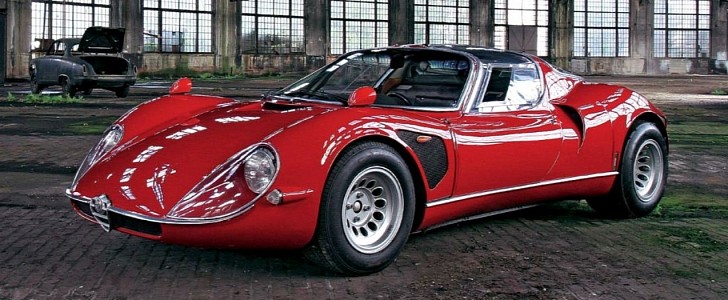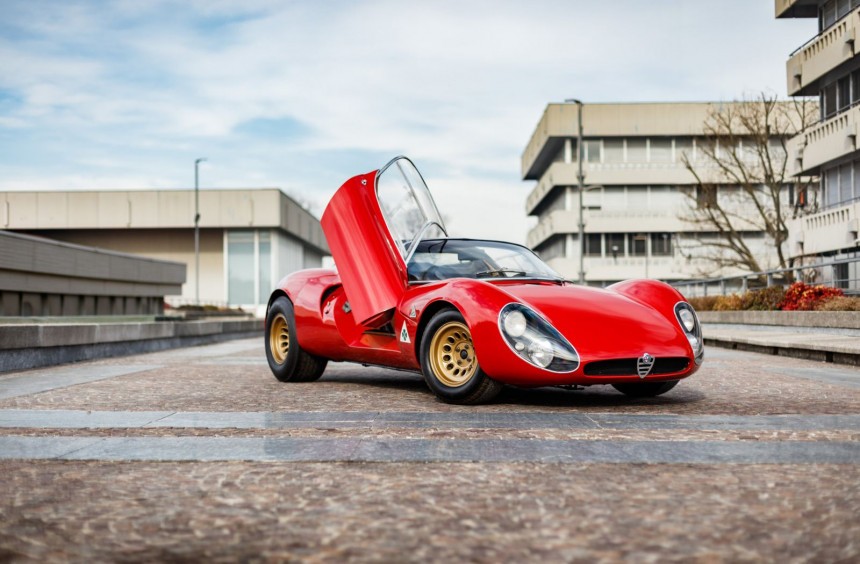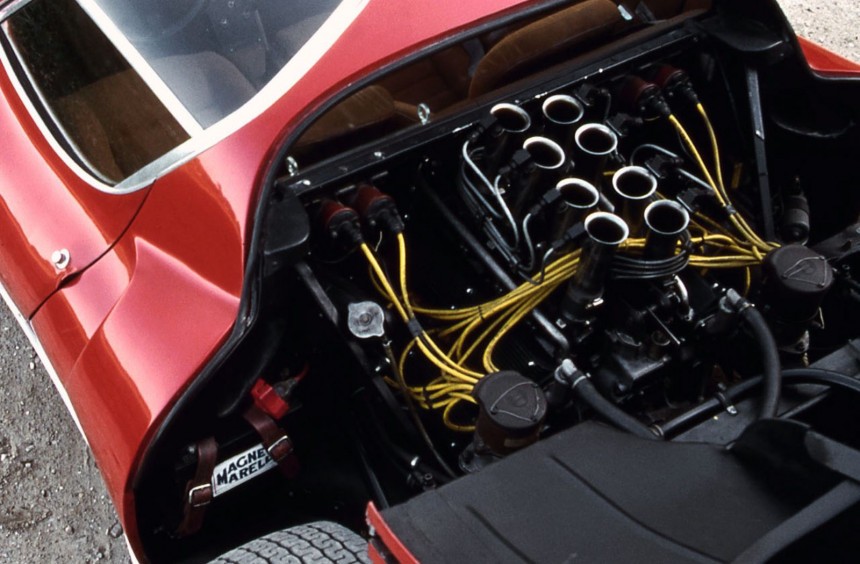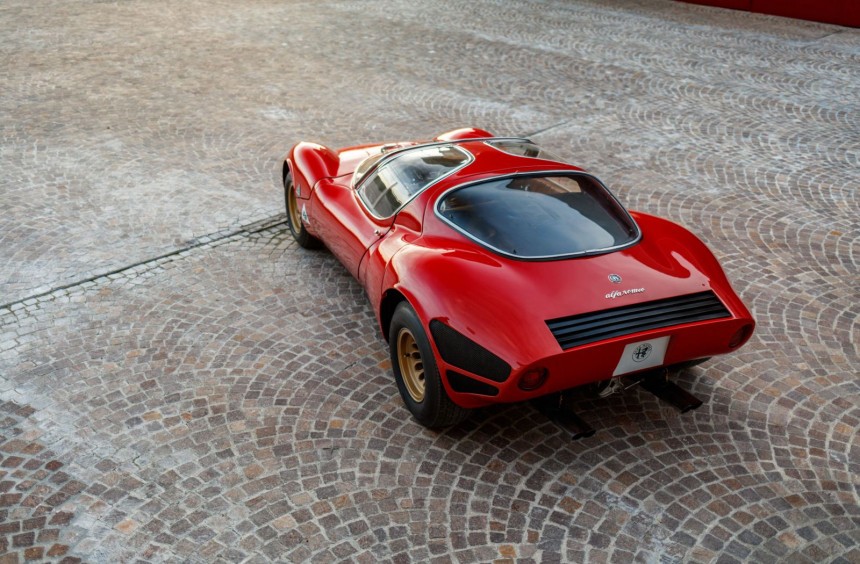If there was ever a contest for the most beautiful car ever built, the 33 Stradale would be the overwhelming favorite. A rare masterpiece from the golden era of automotive design, it continues to astonish, more than half of a century after being unveiled.
In the 1960s, the automotive industry was flourishing and in Italy, it was being elevated to an artform by talented engineers and designers that would become legendary. The country that gave the world Da Vinci, Michelangelo, Caravaggio, or Botticelli and their masterpieces, would also give car enthusiasts some of the most awe-inspiring machines ever created, like the Ferrari 250 GTO, Lamborghini Miura, Bizzarrini 5300 GT Strada, or the Alfa Romeo 33 Stradale.
The story of this incredible car can be traced to the beginning of the aforementioned decade when Giuseppe Luraghi was appointed CEO of the Milanese carmaker. He was not only responsible for kickstarting the brand’s resurgence in the world of motorsport but also for green lightning the development of this captivating road-legal race car.
In 1963, he decided to turn ex-Ferrari engineer Carlo Chiti’s company Autodelta into the official racing department of Alfa Romeo and after creating the successful Giulia TZ, the Tipo 33 prototype was born. Although the first iteration of this model proved unreliable and uncompetitive, it served as the base for the 33 Stradale which made its debut at the Paris Salon de L'Auto on 5 October 1967.
One of the first true supercars ever built, it was developed alongside the Tipo 33, sharing a very similar aluminum tubular chassis and powertrain.
The mid-mounted V8 was a newly developed race-bred engine that bore no relation to Alfa’s other mass-produced units. Exclusively designed and built by Chiti and his team at Autodelta, the all-aluminum 2.0-liter featured the same dry-sump lubrication system and flat-plane crankshaft as the Tipo 33’s powerplant but its camshafts were chain-driven as opposed to the racer’s gear-driven variants.
Matted to a 6-speed transaxle, it could rev all the way up 10,000 rpm, generating 227 bhp and 152 lb-ft (206 Nm) of torque. However, because this car was hand-built to different specifications, these figures varied from chassis to chassis.
The pièce de resistance of this work of automotive art was the aeronautically inspired bodyshell. Drawn up by Franco Scaglione and built by famous Italian coachbuilding firm Carrozzeria Marazzi, it can be described as a timeless symphony of voluptuous curves and shapes.
The low-slung, lightweight all-aluminum structure’s front fascia starts close to the ground where a subtle vent is decorated by the iconic Alfa shield grille. On each side, the ample front wheel wells that give the car a muscular look flow into the side profile, blending with the first dihedral (or butterfly) doors ever used on a production vehicle. The line is broken up by a pair of elegantly integrated side vents that feed cold air into the engine before bulging again over the rear wheels and receding across the sharp and narrowing rear end.
As was the case with the performance figures, each of the eighteen bodies was slightly different. For example, early iterations had double headlights whereas the later models like the one you can admire in the YouTube video bellow by 19Bozzy92 came with single-headlamp configurations and donned additional vents near the front wheel wells to improve brake cooling.
Inside, the 33 Stradale also had different interior configurations, depending on the chassis. Some were more spartan and race-oriented while others featured an abundance of high-quality leather and more refined dashboard designs.
Weighing around 1,543 pounds (700 kg), it was extremely lightweight for its era and could accelerate from 0 to 62 mph (100 kph) in less than 6 seconds. It achieved this using less than half of the engine displacement of high-performance contemporaries such as the Lamborghini Miura, Ferrari Daytona, or Maserati Ghibli. Moreover, while it wasn’t very comfortable on public roads, it handled supremely on the racetrack, becoming the weapon of choice for those who wanted the ultimate track car back in the sixties.
To own one of these high-tech racing-derived machines meant one had to pay $17,000 (around $133,000 in today’s money) for the privilege, a price that made it the most expensive car of its day.
Out of the 18 chassis built from 1967 to 1969, six of them were supplied without bodywork to coachbuilders Bertone, Pininfarina, or Ital Design and were used as a base for various concepts. The rest of the units were sold to private buyers, except for the second chassis which resides at Alfa Romeo’s official museum in Arese, about 7 miles (12 km) northwest of Milan.
Considered one of the most epic cars ever built, the 33 Stradale is an invaluable piece of automotive history, and the surviving examples rarely change owners. When one does become available, it is expected to demand well over the $10 million mark.
The story of this incredible car can be traced to the beginning of the aforementioned decade when Giuseppe Luraghi was appointed CEO of the Milanese carmaker. He was not only responsible for kickstarting the brand’s resurgence in the world of motorsport but also for green lightning the development of this captivating road-legal race car.
In 1963, he decided to turn ex-Ferrari engineer Carlo Chiti’s company Autodelta into the official racing department of Alfa Romeo and after creating the successful Giulia TZ, the Tipo 33 prototype was born. Although the first iteration of this model proved unreliable and uncompetitive, it served as the base for the 33 Stradale which made its debut at the Paris Salon de L'Auto on 5 October 1967.
The mid-mounted V8 was a newly developed race-bred engine that bore no relation to Alfa’s other mass-produced units. Exclusively designed and built by Chiti and his team at Autodelta, the all-aluminum 2.0-liter featured the same dry-sump lubrication system and flat-plane crankshaft as the Tipo 33’s powerplant but its camshafts were chain-driven as opposed to the racer’s gear-driven variants.
Matted to a 6-speed transaxle, it could rev all the way up 10,000 rpm, generating 227 bhp and 152 lb-ft (206 Nm) of torque. However, because this car was hand-built to different specifications, these figures varied from chassis to chassis.
The low-slung, lightweight all-aluminum structure’s front fascia starts close to the ground where a subtle vent is decorated by the iconic Alfa shield grille. On each side, the ample front wheel wells that give the car a muscular look flow into the side profile, blending with the first dihedral (or butterfly) doors ever used on a production vehicle. The line is broken up by a pair of elegantly integrated side vents that feed cold air into the engine before bulging again over the rear wheels and receding across the sharp and narrowing rear end.
As was the case with the performance figures, each of the eighteen bodies was slightly different. For example, early iterations had double headlights whereas the later models like the one you can admire in the YouTube video bellow by 19Bozzy92 came with single-headlamp configurations and donned additional vents near the front wheel wells to improve brake cooling.
Weighing around 1,543 pounds (700 kg), it was extremely lightweight for its era and could accelerate from 0 to 62 mph (100 kph) in less than 6 seconds. It achieved this using less than half of the engine displacement of high-performance contemporaries such as the Lamborghini Miura, Ferrari Daytona, or Maserati Ghibli. Moreover, while it wasn’t very comfortable on public roads, it handled supremely on the racetrack, becoming the weapon of choice for those who wanted the ultimate track car back in the sixties.
To own one of these high-tech racing-derived machines meant one had to pay $17,000 (around $133,000 in today’s money) for the privilege, a price that made it the most expensive car of its day.
Out of the 18 chassis built from 1967 to 1969, six of them were supplied without bodywork to coachbuilders Bertone, Pininfarina, or Ital Design and were used as a base for various concepts. The rest of the units were sold to private buyers, except for the second chassis which resides at Alfa Romeo’s official museum in Arese, about 7 miles (12 km) northwest of Milan.
Considered one of the most epic cars ever built, the 33 Stradale is an invaluable piece of automotive history, and the surviving examples rarely change owners. When one does become available, it is expected to demand well over the $10 million mark.























